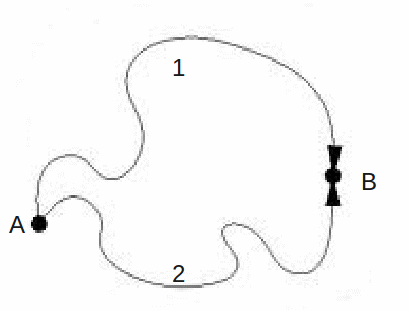If a charge is moved in an electric field from a point A to a point B, the energy difference is proportional to the charge that is moved. Doubling the charge doubles the energy difference, but the energy per unit charge remains fixed.
The energy per unit charge remains fixed, and is called the potential difference between the points.![]()
The Energy Difference in measured in Joules J and the charge is measured in Coulombs C, so the potential difference is measured in J/C. For a given static or non changing electric field, the potential difference between two points is a single fixed quantity. This indicates the work that must be done to move a unit charge from one point to the other, and importantly, does not depend on the route taken. The field is conservative, since we may go from one point to another, and back via a different route, losing no energy in the process. To go from A via 1 to B and returning via 2 to A loses and gains no energy:

![]()
Every point in space may be labelled by a potential – this potential is not unique. Only the potential difference between any two points is well defined, but by giving some point an arbitrary potential we can define the potential of any point relative to this one, giving rise to a potential field.
Potential difference may be expressed in volts. The terms voltage and potential difference are often used interchangeably, but it must be remembered that a voltage is the potential difference between two points, one of which is usually taken as zero, and potential difference is the technically correct term.
